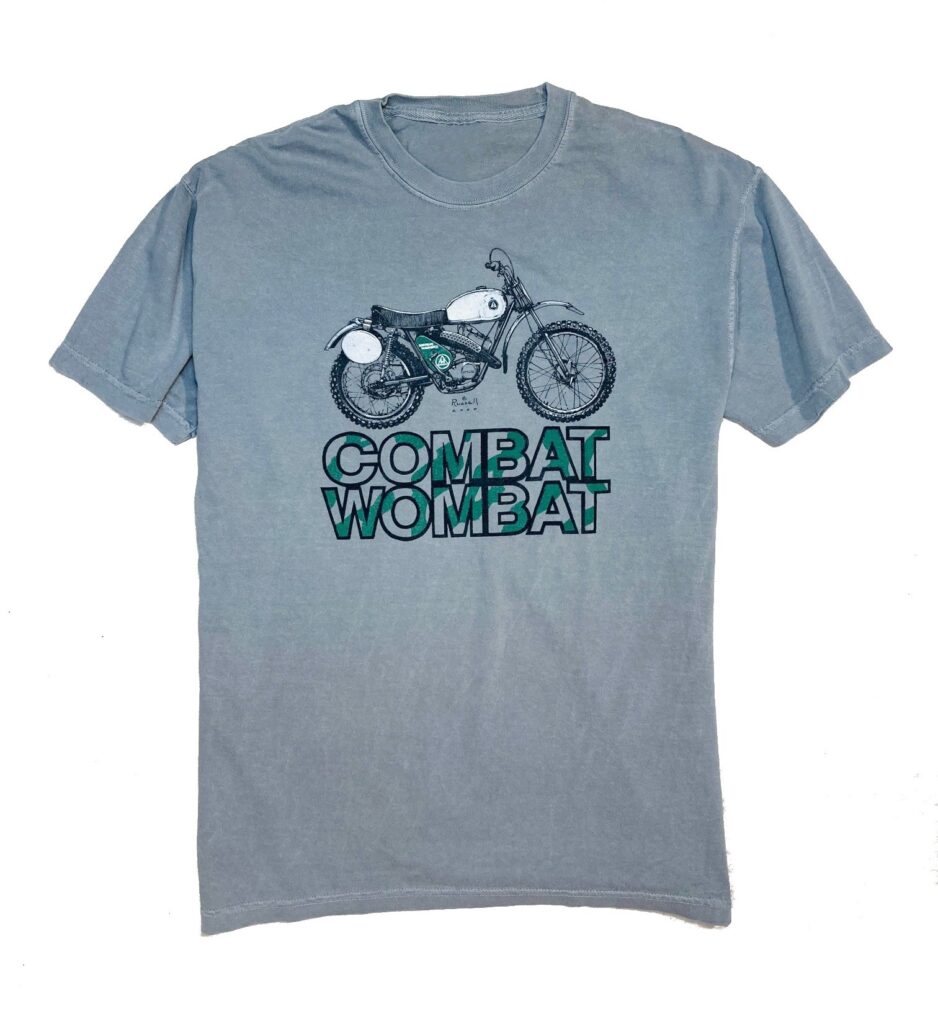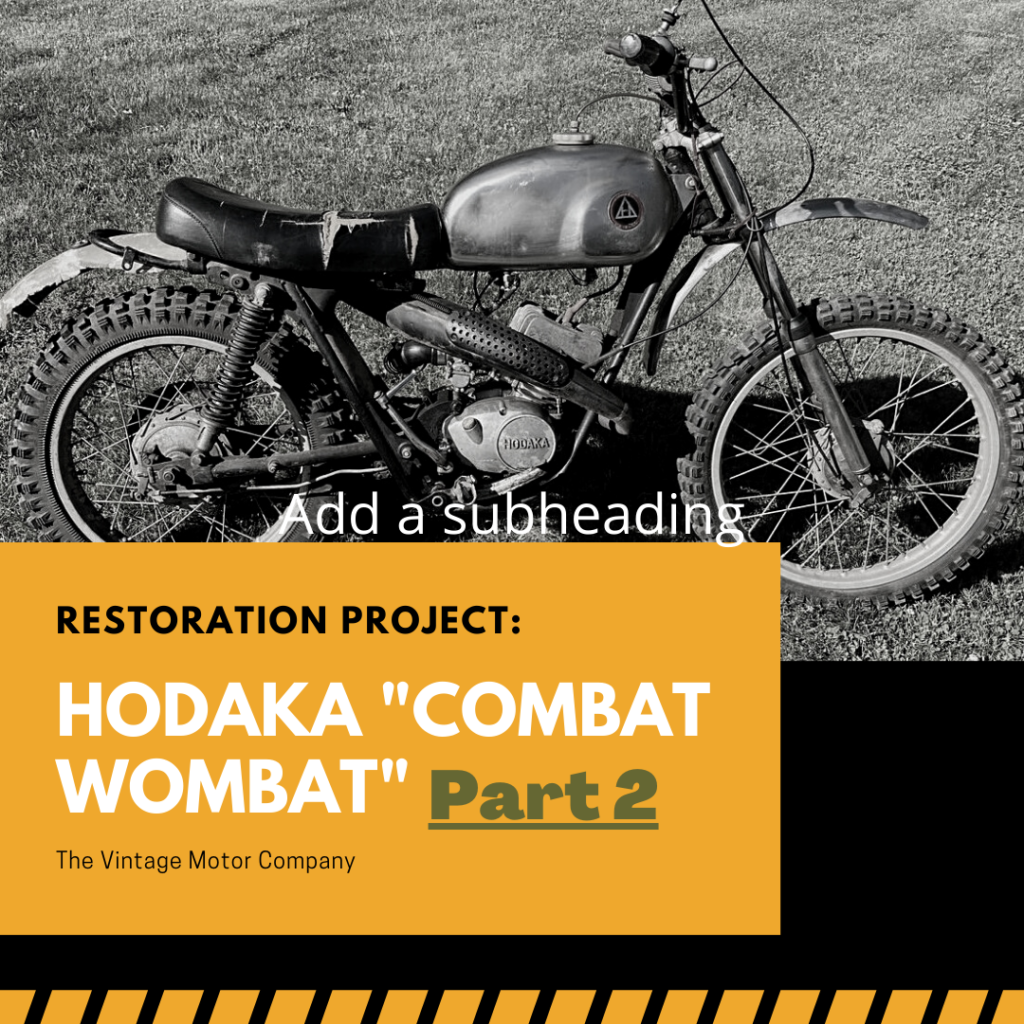No products in the cart.
Hodaka
Combat Wombat Restoration Project
Part 2: Combat Time
If you haven’t read Part 1 of our series, where, as mostly Maico restoration guys, we ‘Enter the Combat’ zone with equal parts excitement and trepidation, you can read the first installment HERE.
Planning
“A little planning never hurt anyone.” I don’t know whether it was the US military or my mom who conveyed this truth to me, but, whoever it was, they were correct. I would further submit that a large part of fun of a motor restoration—for me, anyway—is the “work flow plan” which will get me to the final completion. You know: working out those details and sequences of action that make various vendors and timetable work together. Like . . .
- You need to source bearings and gaskets before the lower end can be rebuilt.
- Cases and hubs can be sent for polishing or repair . . . while the seals and spokes are on-order.
- Blasting comes before painting . . . and painting before assembly . . . and if you want to have the decals clear-coated, you need to obtain them and get them to the painter’s in time.
- You’re driving out by the blaster’s today . . . so maybe you can pick up parts and deliver them to such-and-such, tomorrow, when you’re out that way for work.
- You need to have the cylinder checked out and know what size it will be bored to, before you can order the piston & rings . . . and you want to blast the cylinder, before you bore it . . . and you may want to paint the cylinder after you bore it, but before assembly.
You know what I mean. A good restoration—besides being an adventure—is a well-executed plan. A good plan can get things done in a timely manner, reduce wasted trips and expense, and keep your work area from being clogged with a disassembled motorcycle for months—or years. Planning ahead simply makes things work more smoothly and progressively. Besides this sort of “operational” planning, what other planning might we want to do, before we succumb to our desire to rip the old motorcycle apart?
Financial planning
Thirty years ago, vintage motorcycle deal-making legend David Curci passed on the following dictate to me; I call it the Golden Rule of Old Motorcycle Buying, and I’ve never forgotten it. It is simple, applicable to 98% of old bike purchases, and will keep you out of certain types of trouble:
“Only pay as much for a bike today as you can sell it for, tomorrow.”
The rule is brilliant counsel; it is a preventative vaccination against monetary over-reach, self-imposed marital problems, and not looking dumb in front of your bike friends. Use the rule. Commit it to memory and review it whenever potential purchases of passion arise.
Detailed expenditure planning (or, Where do I draw the line?)
Or, paraphrased even another way, “How much is this sucker gonna cost me to restore?” Having satisfied ourselves that the lump (or treasure) we’re considering spending the mortgage money on is in fact worth what we’re paying (as it sits), we will extend our planning to include the cost of the restoration process. This new question can be phrased, “Will I be able to recoup what I spend on restoration—or will I have spent myself into a financial hole?” (Or, in the real estate context, will I be “under-water?”) Discounting ‘fun’ for the moment, I will nevertheless advocate for always avoiding getting in “over one’s head” (financially) in a restoration. There may be times when such spending is warranted (for example, a family heirloom), but it’s not generally a prudent course of action, for most of us. (As an aside, this reminds me of what “rodders” seem to do—at least anecdotally. That is, they might spend $130,000 and 1,000 hours building the finest candy-apple purple, custom, chopped ’32 Ford with a Jag rear end and a blown 289 in this end of the state. And then they sell it for $65,000 the following year, to fund their next project. You are not a rodder. Do not behave this way!)
Thus, before embarking on my Hodaka (or Husky, or Maico, or Yamaha, etc.) LoveFest, I need to estimate what I’m getting into, money-wise. (I like to repeat truthfully to my friends and family that I’ve never lost money on a vintage motorcycle purchase. It’s factual to date, and I hope to be able to continue saying it.) Of course, we can’t predict the future with 100% accuracy, but we can perhaps get close. It’s best to be honest with ourselves. With respect to the Combat, here’s my pre-game estimate of expenditures that will be required to take it to, let’s say, a “very high level” of restoration:
-Sandblasting & glass beading $100
-Paint (doing the frame myself. Air-box is another line item.) $50
-Powder coating (kickstand, brake lever, etc.) $50
-New spokes, front & rear (eBay) $100
-Tires, front & rear $100
-Fenders, front & rear $300
-New gas tank $420
-Tank emblems, decals $50
-Brake lever & mount $30
-Cables (3) $90
-Engine work 0 (I’ll explain, later)
-Sprockets $40
-Chain $20
-Used air-box, plus paint $200
-Grips, kicker rubber $20
-Handlebars $30
-Fork seals & oil $20
-Used seat foam $20
-New seat cover $50
-Fuel tap $30
-Air filter 0 (Will make my own from Uni kit, already on hand.)
-Tubes 0 (Will re-cycle from my own used tube collection)
-Various fasteners, pain, sandpaper, oil, widgets that I forgot, etc. $100
TOTAL, estimated……………………………………….$1,820.00
By “very high level of restoration” I mean something along the lines of this beautiful Combat, on display at this summer’s AACA Motorbike Day.
Win, lose or draw
This is the juncture at which the owner might consider what path to follow, with respect to restoring or not. Let’s remember that we don’t have to restore any motorcycle; some clearly don’t warrant restoration. This could be for several reasons: historical considerations; simply being really nice, as is; or for monetary or time considerations. In our 2018 AACA Museum exhibit (The Dilemma), I examined the attitudes of three groups of collector/enthusiasts towards “restoring” antiques. Briefly stated, antique auto hobbyists are very prone to restore—it’s the keystone activity of the hobby; antique American furniture collectors tend to fervently avoid restoration and changes to construction and finish; and vintage motorcycle enthusiasts are somewhere in the middle—appreciating the challenge of a restoration, but still able to enjoy the “patina” that years and use have bestowed on the object. An example of this last case is actually another Hodaka that I own. It’s a 1971 Super Rat that I picked up in parts, for next-to-nothing, years ago—basically for the sake of the Webco head it sported. I rebuilt the engine (using the new parts that conveniently came with it), cleaned it, replaced a few of the missing and crustiest parts, added a period (also crusty) metal hand-painted number plate . . . and enjoy it just the way it is. My reasons for not continuing forward with a full restoration are: first, I love the way it looks, presently; second, the costs would be very significant; third, I took the easy way out and reassembled the engine using cosmetically-damaged inner cases (meaning I’d need to go back and split the cases); and, fourth, I’m just not that personally interested in the Super Rat. This last reason is nothing against Hodakas or Super Rats; I simply don’t have the emotional attachment to them or technical interest in them that others may. (And they may have the same feeling about early 1970s Kawasaki G3s and G4s, which I fawn over. May each of us enjoy his or her own passion.)
But, back to our Combat Wombat. When I add the purchase price of $500 for my Combat, I find myself coming in at $2,320 for a highly-restored motorcycle—and one that I’m aesthetically drawn to and historically interested in. I’m thus confident about investing money—and time—in this project. While not an expert on Hodakas in any way, I feel very comfortable that the finished, running machine can be sold—when necessary, whether next year or in twenty years—for much more than my investment . . . in dollars, at least; time not included! (Time is another and by no means insignificant commodity. I’m doing this for fun. If I was a professional, I’d want very much to account for all the time involved. Even for recreational restorers, I suggest you double-check yourself as to whether the several hundred labor hours you’ll invest in a project will indeed be “worth it,” when looking back. Time spent is time that will not be recovered; we all want to think we prudently used the time we’ve been given for work, for family, for pursuits other than our own amusement, when we look back. As racer/pastor Steve Wise recently asked, “You’re not putting that bike in your coffin, are you?”)
Now, about that “zero-dollar” engine. Let me first state that my estimate, above, is tailored to this particular project and situation, only. A different machine will have a very different list of work required and expenses incurred. In this particular case, my engine appears to be running and in need of very little—especially since I don’t plan to race, or even regularly run, the bike. I’ve looked the engine over, and feel very confident it will start and won’t need a substantial infusion of dollars. My deduction is based upon an examination revealing:
- A good spark
- Good compression—and no funny sounds when the engine is pushed through its cycle.
- The engine shifts up & down through the gears
- The clutch . . . clutches
- Inspection of the cases & fins: no damage.
- The seller’s statement that it ran
- Every indication that the previous owner had been riding it: gas in the tank and no missing kick-starter or chain (In my experience, a missing chain or kick-starter often accompanies a non-running motorcycle.)
What if the engine did need significant rebuilding—as is usually the case with an old dirt bike? Looking at a typical vintage rebuild situation that I’m familiar with, a poor condition Maico (or Husky or OSSA or CZ, etc.) engine that needed, say, a new top-end, a new clutch & primary chain, bearings & seals, and maybe a few NOS gears, could easily get into the $1200 range, in parts alone. Then, throw in some expert case repairs, and having someone else bore the cylinder, press in the rod, and assemble it all, and you can be into “real money” on the engine. A $2000 engine rebuild quickly increases the total restoration outlay. If my Combat engine appeared to need all the above, I would likely either a)look for a better, intact engine to start with, or b)think again about the whole project.
Summarizing my planning phase—including both work flow and financial planning—I see that I’m “good to go” with the restoration. That is, I have a rough idea of the order in which I’ll approach the work, and I’ve calculated that the overall project is worth my while in both dollars and time.
Next installment: Combat Time, Part 3: Getting Dirty
If you enjoyed the article, please consider “Liking” us on Facebook or supporting the Vintage Motor Company by checking out our shopping page located here. It also just happens that we think these are the coolest vintage bike t-shirts available anywhere – and many others agree!


